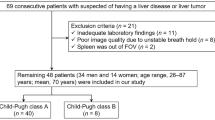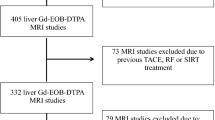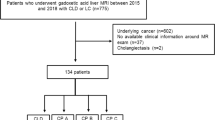Abstract
Objectives
This study aimed to evaluate the feasibility of using the hepatocyte enhancement fraction (HEF) based on gadoxetic acid-enhanced magnetic resonance imaging (MRI) for assessing the liver function in patients with chronic hepatitis B.
Methods
Sixty patients with Child–Pugh grade A (CP-A), 18 with Child–Pugh grade B (CP-B), 2 with Child–Pugh grade C (CP-C), and 20 with normal liver function (NLF) were enrolled. Gadolinium ethoxybenzyldiethy-lenetriaminepentaacetic acid (Gd-EOB-DTPA)-enhanced MRI was conducted. T1 mapping imaging was performed before and 20 min after Gd-EOB-DTPA administration. The pre- and post-contrast T1 values of the liver (T1pre and T1post), increase in the T1 relaxation rate (ΔR1), rate of decrease in the T1 relaxation time (ΔT1), HEF, and uptake coefficient (K) parameters in the NLF, CP-A, and CP-B + CP-C groups were compared using one-way analysis of variance. The effectiveness of each parameter in differentiating the NLF + CP-A group from the CP-B + CP-C group was evaluated using the receiver operating characteristic (ROC) curve.
Results
The HEF, K, ΔT1, and ΔR1 values decreased, while the T1post and T1pre values increased, with the increase in liver function damage. Significant differences in T1post, ΔT1, ΔR1, and HEF were found between different groups, except for the CP-A and NLF groups. However, no significant difference was observed in the T1pre among the three groups. HEF exhibited the largest area under the ROC curve.
Conclusion
The HEF is an effective method for evaluating liver function in patients with hepatitis B.




Similar content being viewed by others
References
Global Burden of Disease Cancer Collaboration, Fitzmaurice C, Allen C, et al. (2017) Global, Regional, and National Cancer Incidence, Mortality, Years of Life Lost, Years Lived With Disability, and Disability-Adjusted Life-years for 32 Cancer Groups, 1990 to 2015: A Systematic Analysis for the Global Burden of Disease Study. JAMA Oncol. 3(4): 524-548. https://doi.org/10.1001/jamaoncol.2016.5688
Mokdad AA, Lopez AD, Shahraz S, et al. (2014) Liver cirrhosis mortality in 187 countries between 1980 and 2010: a systematic analysis. BMC Med. 12: 145. https://doi.org/10.1186/s12916-014-0145-y
McCormack L, Petrowsky H, Jochum W, Furrer K, Clavien PA. (2007) Hepatic steatosis is a risk factor for postoperative complications after major hepatectomy: a matched case-control study. Ann Surg. 245(6): 923-930. https://doi.org/10.1097/01.sla.0000251747.80025.b7
Schreckenbach T, Liese J, Bechstein WO, Moench C. (2012) Posthepatectomy liver failure. Dig Surg. 29(1): 79-85. https://doi.org/10.1159/000335741
Rahbari NN, Garden OJ, Padbury R, et al. (2011) Posthepatectomy liver failure: a definition and grading by the International Study Group of Liver Surgery (ISGLS). Surgery. 149(5): 713-724. https://doi.org/10.1016/j.surg.2010.10.001
Wang YY, Zhao XH, Ma L, et al. (2018) Comparison of the ability of Child-Pugh score, MELD score, and ICG-R15 to assess preoperative hepatic functional reserve in patients with hepatocellular carcinoma. J Surg Oncol. 118(3): 440-445. https://doi.org/10.1002/jso.25184
Cucchetti A, Cescon M, Trevisani F, Pinna AD. (2012) Current concepts in hepatic resection for hepatocellular carcinoma in cirrhotic patients. World J Gastroenterol. 18(44): 6398-408. https://doi.org/10.3748/wjg.v18.i44.6398
Yoon JH, Lee JM, Paek M, Han JK, Choi BI. (2016) Quantitative assessment of hepatic function: modified look-locker inversion recovery (MOLLI) sequence for T1 mapping on Gd-EOB-DTPA-enhanced liver MR imaging. Eur Radiol. 26(6): 1775-82. https://doi.org/10.1007/s00330-015-3994-7
Yamada A, Hara T, Li F, et al. (2011) Quantitative evaluation of liver function with use of gadoxetate disodium-enhanced MR imaging. Radiology. 260(3): 727-733. https://doi.org/10.1148/radiol.11100586
Dahlqvist Leinhard O, Dahlström N, Kihlberg J, et al. (2012) Quantifying differences in hepatic uptake of the liver specific contrast agents Gd-EOB-DTPA and Gd-BOPTA: a pilot study. Eur Radiol. 22(3): 642-653. https://doi.org/10.1007/s00330-011-2302-4
Wang L, Collins C, Kelly EJ, et al. (2016) Transporter Expression in Liver Tissue from Subjects with Alcoholic or Hepatitis C Cirrhosis Quantified by Targeted Quantitative Proteomics. Drug Metab Dispos. 44(11): 1752-1758.
Heye T, Yang SR, Bock M, et al. (2012) MR relaxometry of the liver: significant elevation of T1 relaxation time in patients with liver cirrhosis. Eur Radiol. 22(6): 1224-1232. https://doi.org/10.1007/s00330-012-2378-5
Haimerl M, Utpatel K, Verloh N, et al. (2017) Gd-EOB-DTPA-enhanced MR relaxometry for the detection and staging of liver fibrosis. Sci Rep. 7: 41429. https://doi.org/10.1038/srep41429.
Bataller R, Brenner DA. (2005) Liver fibrosis. J Clin Invest. 115(2): 209-18. https://doi.org/10.1172/JCI24282
Rodríguez-Moreno F, González-Reimers E, Santolaria-Fernández F, et al. (1997) Zinc, copper, manganese, and iron in chronic alcoholic liver disease. Alcohol. 14(1): 39-44.
Katsube T, Okada M, Kumano S, et al. (2011) Estimation of liver function using T1 mapping on Gd-EOB-DTPA-enhanced magnetic resonance imaging. Invest Radiol. 46(4): 277-283. https://doi.org/10.1097/RLI.0b013e318200f67d
Yoon JH, Lee JM, Kim E, Okuaki T, Han JK. (2017) Quantitative Liver Function Analysis: Volumetric T1 Mapping with Fast Multisection B1 Inhomogeneity Correction in Hepatocyte-specific Contrast-enhanced Liver MR Imaging. Radiology. 282(2): 408-417. https://doi.org/10.1148/radiol.2016152800
Poon RT, Fan ST. (2005) Assessment of hepatic reserve for indication of hepatic resection: how I do it. J Hepatobiliary Pancreat Surg. 12(1): 31-7. https://doi.org/10.1007/s00534-004-0945-0.
Author information
Authors and Affiliations
Corresponding authors
Ethics declarations
Conflicts of interest
The process and results of this study are not affected by the relevant equipment, materials, and pharmaceutical enterprises.
Additional information
Publisher's Note
Springer Nature remains neutral with regard to jurisdictional claims in published maps and institutional affiliations.
Rights and permissions
About this article
Cite this article
Liu, MT., Zhang, XQ., Lu, J. et al. Evaluation of liver function using the hepatocyte enhancement fraction based on gadoxetic acid-enhanced MRI in patients with chronic hepatitis B. Abdom Radiol 45, 3129–3135 (2020). https://doi.org/10.1007/s00261-020-02478-7
Published:
Issue Date:
DOI: https://doi.org/10.1007/s00261-020-02478-7




